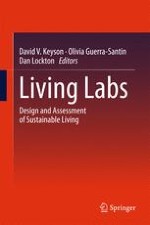2017 | OriginalPaper | Chapter
26. Relationship Between Building Technologies, Energy Performance and Occupancy in Domestic Buildings
Author : Olivia Guerra-Santin
Published in: Living Labs
Publisher: Springer International Publishing
Activate our intelligent search to find suitable subject content or patents.
Select sections of text to find matching patents with Artificial Intelligence. powered by
Select sections of text to find additional relevant content using AI-assisted search. powered by
